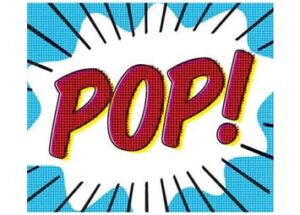 “Can you do something to make it pop?” It’s one of the most common questions creatives hear—and it’s also one of the most infuriating, blood-boiling, exasperating questions ever asked, making designers, copywriters and creative directors want to scream. In fact, it has even topped the list of most annoying industry buzzwords and clichés reported by marketing and advertising executives.
“Can you do something to make it pop?” It’s one of the most common questions creatives hear—and it’s also one of the most infuriating, blood-boiling, exasperating questions ever asked, making designers, copywriters and creative directors want to scream. In fact, it has even topped the list of most annoying industry buzzwords and clichés reported by marketing and advertising executives.
Talk about a backhanded compliment: “Make it pop” and its equally exasperating brethren—“I’ll know it when I see it” and “show me some options”—all imply that you intentionally withheld your best effort, or that you have something up your sleeve reserved to spruce up a project when “good enough” doesn’t quite cut it. If only you could just add a dash of glitter—or perhaps a few firecrackers—to “make it pop” in the critical eye of the naysayer who dared to utter this foul phrase.
Besides being ambiguous, cryptic and completely useless as feedback, phrases like “make it pop” and “I’ll know it when I see it” actually mean “I have no idea what I want.” Although they’d never admit it, stakeholders who make these aggravating requests are clearly signaling a lack of concrete strategic direction.
This might not be your problem, but fixing it does fall squarely on your shoulders. Thankfully, with a little preparation, you can help your stakeholders home in on their vision consistently. Here are four steps to “make it pop” every time:
- Work with stakeholders to define a strategy up front. Identify goals for each project and specify how these map to overall business objectives. By agreeing on the audience, key messages or takeaways, and desired results at the beginning of a project, it’s easier to develop a compelling, creative deliverable that hits the mark the first time quite simply because you’ve defined the mark. For instance, the sales team may request a product sales sheet, but when asked to define exactly what the resulting piece should accomplish, you might realize a sales sheet isn’t the best option. Avoid the rework, stress and frustration by starting with the goals up front and then determining the best vehicle and creative treatment to get you there.
- Use templates to streamline the workflow. Many organizations already use creative briefs, but they’re often barebones and fail to capture the full scope of the project’s goals and objectives. Become a creative brief ninja by providing a thorough template that requires precision, accuracy and focus on the complete strategy, goals and creative direction as well as typical logistical details and assignment requirements like job specs and quantity. Demanding that stakeholders put their thoughts on paper (literally or digitally) helps tremendously to flesh out the ideas and alleviate misunderstanding and miscommunication during the creation and review process. In fact, well-designed digital templates can accelerate other parts of the process too, like preparing and issuing bid requests for suppliers, purchasing and procurement, and travel expense tracking and reporting.
- Use inline digital proofing to stop the editing insanity. Submitting proofs for review can be like opening a can of worms—there’s lots of wriggling and wrangling, and it’s hard to contain. Everyone has his or her own opinion, which leads to 15 marked-up versions in circulation. Get a handle on the review process by implementing an inline digital proofing solution that enables stakeholders to submit feedback and edits in real time and in a single location so everyone is working on the same version. Each reviewer has visibility into the others’ input/thoughts/ideas to gain context into change requests, and you can finally stop chasing drafts and spend more time creating.
- Measure—and take appropriate action. Let’s assume you finally “make it pop,” and everyone’s thrilled. Now, how do you make that magic happen the next time? It’s virtually impossible to maintain consistent success without taking a continuous pulse on what works—and what doesn’t—at each stage of the process. Measuring effectiveness and results at each project phase is crucial to identifying bottlenecks and averting hiccups that can balloon into disaster as your deadline approaches. But simply knowing where things went wrong is only the first step; you must implement change for continuous improvement to get off the perpetual “make it pop” merry-go-round. Rather than drastically changing the process, harness that incremental data to make smaller changes across the project lifecycle. This subtle approach will ease the transition and reduce friction with new processes among stakeholders, and it will enable your team to still meet production demands without getting hung up on the process itself. Of course, measuring performance of the creative content once it hits the market is vital, too. Knowing exactly what resonated with the audience to drive the desired behavior is the ultimate intel for figuring out how to “make it pop” the next time.
The bottom line is that cryptic phrases like “make it pop” and “I’ll know it when I see it” are really cries for help. When stakeholders lack the vision and strategy to request what they really want, it’s impossible for even the most talented team to please their picky palate. Helping them find that vision, define a clear strategy and then use it to guide the entire process is an incredibly valuable service that any creative team can—and should—provide.
When everyone’s on the same page, with clearly defined goals, everything “pops,” and your team can finally be recognized as the rock stars they truly are.
Bryan Nielson is the executive vice president, strategy, go-to-markets & product, AtTask.
 Network
Network

